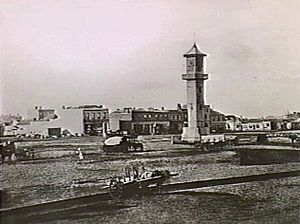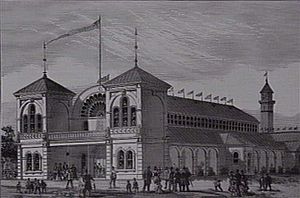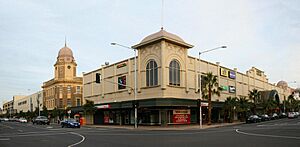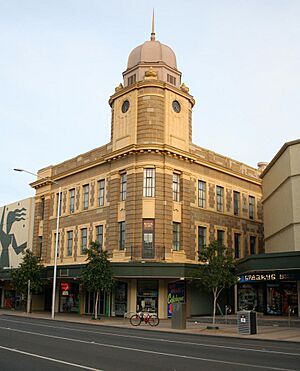Market Square, Geelong facts for kids

Market Square was once a big open space in the middle of Geelong, Victoria, Australia. It was about 2.9 hectares (almost 7 acres) in size. Governor Sir George Gipps set aside this land as a town square when Geelong was first being planned. Over time, it became a market where people sold fresh food. Later, buildings were constructed on the site. Today, the Market Square Shopping Centre stands there. It was opened in 1985 by the City of Geelong.
Contents
History of Market Square
In 1850, a man named Mr. William Grey put a water tank in the square. This tank helped provide water for people's homes.
The Famous Clock Tower
A special clock tower was built in the middle of Market Square in 1856. It was the idea of James Austin, who was the second mayor of Geelong. He wanted to pay for a clock tower to mark his time as mayor.
The clock was even shown in a famous newspaper called The Illustrated London News in March 1855. Parts for the clock arrived in Geelong from England in November 1855. However, it took a while to decide where to put the clock. Finally, in July 1857, the first stone for the tower was laid in Market Square.
The clock tower was made from cream and brown tiles. These tiles were held together by fancy cast-iron designs. The tower was about 18 metres (60 feet) tall and 2 metres (7 feet) wide. It had stairs inside that went all the way to the top. There was a platform at the top with a railing. The clock needed to be wound up once a week.
At the very top of the tower, there was a shiny golden kangaroo. It worked like a weather vane, showing which way the wind was blowing. Sir Thomas Maltby described it as a "lifelike model of a Kangaroo about four feet high." He later bought this kangaroo, saving it from being scrapped. It still works perfectly today!
The clock tower stayed in place until October 1923. It was taken down to make room for the CML Building. Many people were upset about this. It was too hard to move the tower in one piece, so it was pulled down using strong steel cables. Today, a special plaque in the Market Square Shopping Centre shows where the clock tower once stood.
The Exhibition Building
An exhibition building opened in Market Square on December 27, 1881. It was located to the west of the Clock Tower. This building had two tall corner towers, a large balcony, and a big, round window to let light into the main hall. It hosted a huge art and industry show for four months. More than 30,000 items were on display!
After the exhibition, the building became a place for live performances. It could hold 1,500 people and was known as the Exhibition Theatre. Later, it was called Her Majesty's, and then His Majesty's after Queen Victoria passed away. Famous singer Dame Nellie Melba performed there in February 1915.
By 1936, when the theatre closed, other buildings had grown up around it. The building was then used by Cowley's Motor Garage.
A Green Town Square
After the exhibition building was built, the land to its west was turned into a beautiful town square. Trees were planted, and a fountain was added.
When Queen Victoria died in 1901, people in Geelong wanted to build a statue to remember her. A competition was held to design the statue. Mr. Clement Nash won the competition. A sculptor named John Swan Davie created the statue.
The statue weighed two tonnes. It was officially shown to the public on May 24, 1904. In 1912, it was moved to the entrance of Eastern Park. This was because the Solomons Building was going to be built on the same spot.
Solomons Department Store
In 1912, the western side of Market Square was cleared for the Solomons Building. This building was a large department store owned by Mr. Julius Solomon. It opened on April 16, 1913. At the time, it was the third largest store in Victoria without internal walls.
Mr. Solomon had wanted to build a store in Market Square for five years. He was allowed to build on this land, which was owned by the government. The agreement was that the buildings would become the council's property after 50 years. Solomons closed in 1966 and was replaced by a Woolworths supermarket. Later, in the 1980s, the building became part of the new Market Square Shopping Centre.
The CML Building
The Colonial Mutual Life Assurance (CML) Building was announced on May 28, 1923. This building for the insurance company was going to be built where the clock tower stood. The clock tower was taken down in October 1923. The new CML building was a three-story stone office building. It was designed with a new clock tower to hold the old clock, topped with a copper dome. Like the Solomons Building, this building would also become the council's property after 50 years.
Parking for Cars
By the 1960s, more and more cars were in Geelong. This meant there was a need for more places to park in the city centre. To help with this, Cowley's Motor Garage (which was on the old Exhibition Building site) was taken down. A three-level concrete car park was built instead. It opened on October 20, 1961. This car park could hold 200 cars. It also offered fuel, oil changes, and car washing services.
Building a Shopping Centre
The 1980s brought new ideas for updating the centre of Geelong. In 1981, a plan was suggested for a huge shopping centre. It would stretch from Little Malop Street all the way to the waterfront.
This big plan did not happen. Instead, the City of Geelong decided to build its own shopping centre on the Market Square site. Work to clear the land for the new shopping centre began in 1984. The CML Building on Malop Street was kept and used for offices. The front parts of the Corio Stores on Little Malop Street and the Solomons Building on Moorabool Street were also saved and used in the new shopping centre. This development also meant that Jacobs Street was closed.
Images for kids
-
A plaque marking the spot where the old clock tower once stood.









